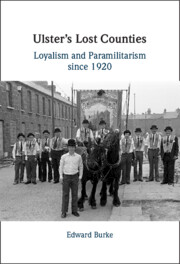474 results
7 - EU Governance of Public Services and Its Discontents
- from Part II - EU Economic Governance in Two Policy Areas
-
- Book:
- Politicising Commodification
- Published online:
- 30 May 2024
- Print publication:
- 06 June 2024, pp 132-164
-
- Chapter
-
- You have access
- Open access
- HTML
- Export citation
6 - EU Governance of Employment Relations and Its Discontents
- from Part II - EU Economic Governance in Two Policy Areas
-
- Book:
- Politicising Commodification
- Published online:
- 30 May 2024
- Print publication:
- 06 June 2024, pp 95-131
-
- Chapter
-
- You have access
- Open access
- HTML
- Export citation
9 - EU Governance of Water Services and Its Discontents
- from Part III - EU Economic Governance in Three Sectors
-
- Book:
- Politicising Commodification
- Published online:
- 30 May 2024
- Print publication:
- 06 June 2024, pp 204-230
-
- Chapter
-
- You have access
- Open access
- HTML
- Export citation
10 - EU Governance of Healthcare and Its Discontents
- from Part III - EU Economic Governance in Three Sectors
-
- Book:
- Politicising Commodification
- Published online:
- 30 May 2024
- Print publication:
- 06 June 2024, pp 231-266
-
- Chapter
-
- You have access
- Open access
- HTML
- Export citation
The clinical pathway in ADMiRE, Ireland’s first public specialist service for children and adolescents with attention deficit hyperactivity disorder
-
- Journal:
- Irish Journal of Psychological Medicine , First View
- Published online by Cambridge University Press:
- 03 June 2024, pp. 1-8
-
- Article
-
- You have access
- Open access
- HTML
- Export citation
Chapter 10 - Reputation in Ireland
- from Part II - Publishing History and Legacy
-
-
- Book:
- Jonathan Swift in Context
- Published online:
- 02 May 2024
- Print publication:
- 09 May 2024, pp 75-82
-
- Chapter
- Export citation
Chapter 34 - Dublin
- from Part V - The External World
-
-
- Book:
- Jonathan Swift in Context
- Published online:
- 02 May 2024
- Print publication:
- 09 May 2024, pp 270-276
-
- Chapter
- Export citation
Chapter 40 - Colonialism
- from Part VI - Social and Intellectual Topics
-
-
- Book:
- Jonathan Swift in Context
- Published online:
- 02 May 2024
- Print publication:
- 09 May 2024, pp 319-326
-
- Chapter
- Export citation
Chapter 42 - Demography
- from Part VI - Social and Intellectual Topics
-
-
- Book:
- Jonathan Swift in Context
- Published online:
- 02 May 2024
- Print publication:
- 09 May 2024, pp 335-342
-
- Chapter
- Export citation
Chapter 32 - Literary Scene
- from Part V - The External World
-
-
- Book:
- Jonathan Swift in Context
- Published online:
- 02 May 2024
- Print publication:
- 09 May 2024, pp 255-262
-
- Chapter
- Export citation
Chapter 33 - The Church of Ireland
- from Part V - The External World
-
-
- Book:
- Jonathan Swift in Context
- Published online:
- 02 May 2024
- Print publication:
- 09 May 2024, pp 263-269
-
- Chapter
- Export citation
Chapter 1 - Introduction
-
- Book:
- Ulster's Lost Counties
- Published online:
- 18 April 2024
- Print publication:
- 25 April 2024, pp 1-30
-
- Chapter
- Export citation
Chapter 5 - The Last Ditch
-
- Book:
- Ulster's Lost Counties
- Published online:
- 18 April 2024
- Print publication:
- 25 April 2024, pp 185-237
-
- Chapter
- Export citation
Exploring the Baltinglass cursus complex: routes for the dead
-
- Article
-
- You have access
- Open access
- HTML
- Export citation
Chapter 7 - Conclusion
-
- Book:
- Ulster's Lost Counties
- Published online:
- 18 April 2024
- Print publication:
- 25 April 2024, pp 293-303
-
- Chapter
- Export citation
Chapter 6 - A Suspect Population
-
- Book:
- Ulster's Lost Counties
- Published online:
- 18 April 2024
- Print publication:
- 25 April 2024, pp 238-292
-
- Chapter
- Export citation

Ulster's Lost Counties
- Loyalism and Paramilitarism since 1920
-
- Published online:
- 18 April 2024
- Print publication:
- 25 April 2024
Chapter 4 - England and Ireland
- from Part I - Places
-
-
- Book:
- Robert Lowell In Context
- Published online:
- 28 March 2024
- Print publication:
- 04 April 2024, pp 41-52
-
- Chapter
- Export citation
1 - Applied Science Conceived
- from Stage 1 - Origins and Pedagogy in the Nineteenth Century
-
- Book:
- Applied Science
- Published online:
- 15 March 2024
- Print publication:
- 28 March 2024, pp 19-43
-
- Chapter
- Export citation
10 - British Reformations Compared
-
-
- Book:
- Reformations Compared
- Published online:
- 14 March 2024
- Print publication:
- 21 March 2024, pp 214-241
-
- Chapter
- Export citation



